9. "Victory" at the Beach
Walk-throughs and reviews of two vintage Victory brand jigsaw puzzles that have seaside scenes (about 4200 words; 30 photos)
English “Victory” brand puzzles were made by G.J. Hayter & Company, the world’s largest maker of hand-cut jigsaw puzzles over a period of several decades. Because they were widely available and were made in comparatively large quantities, Victory puzzles are the most common brand to be offered for sale on the internet. Because they were made by anonymous factory workers, and aimed primarily for common folk and the middle-class, they attract less attention from collectors than the ones that were custom made for wealthy customers. They still sell as “collectables” but often for very reasonable prices.
My original plan was to publish an essay about the history of the G.J. Hayter company who made the “Victory” brand of puzzles before posting these reviews, and with it, to re-publish my reports about two Victory puzzles that I assembled before starting this newsletter/blog project.
Those were the puzzles that got me started in researching things related to my puzzles, and they both turned out to have very interesting back-stories. I wrote long reports about them in the Facebook Wooden Puzzle Club group. That was instrumental in inspiring me to start this Bill’s Wooden Jigsaw Puzzles project as a better venue for my long-form reports.
But the essay about the company has turned out to be a much more time-consuming task than I expected, partly because I had the discouraging experience of having a large part of the text that I had written vanish (probably by getting distracted while doing a cut ‘n’ paste to move the text.) Also, I haven’t really begun to prepare the re-publication of my reports of those other two Victory puzzles yet.
I have a self-imposed policy to keep an assembled jigsaw on my puzzle-board until I have written the review-essay about it. This policy gives me an incentive to finish the writing while the memory is still fresh and it also keeps the puzzle available in case I want additional photos.
Well, these new reviews of Victory puzzles are complete, the other writing that I planned to have precede them isn’t, and want to free up my puzzle-boards NOW(!) so I can get back to assembling puzzles.
After a long career as a policy analyst I know that policies can be changed, and that exceptions should be made if circumstances warrant. So here are the reviews of the two Victory puzzles that I just completed. My current plan is to post the history of the company as a stand-alone essay sometime fairly soon, and I’ll re-publish the stories about the other two Victory puzzles someday, but I’m not setting myself any deadline for myself.
[Update: I did publish that history essay about a month after I posted this one. I never did get around to to posting a retro-review of the earlier Victory puzzles that I had assembled earlier but I might still do so someday because I do have them documented in reviews I posted in a Facebook group.]
Also, in this posting I am trying out a change from past practice. Instead of including a photo of the completed puzzle at the beginning I am going to let you see the image develop the way that I experience it during assembly.
A Good Catch
factory hand cut circa early 1940s?
G.J. Hayter & Co. Ltd - Victory Super-Cut series
about 200 pieces 9¾” x 12½” (24x32 cm) scant 5.5mm 3ply hardwood
artist and cutter unidentified
“Victory” brand wooden jigsaw puzzles were made by G.J. Hayter & Company LTD, one of the earliest British companies that made wooden jigsaw puzzles in a factory manufacturing format. In its day it became the largest and the longest-lived one of them all. Throughout the company’s 70 or so year’s existence it stayed with the practice of selling and packaging its better-quality adult jigsaw puzzles without reference images. They believed – STRONGLY – that part of the enjoyment of assembly came from slowly discovering what the image would be.
This puzzle is the closest that I’ve come to date in replicating that experience. As was typical at the time for higher quality adult puzzles, this box has no picture, and I helped by doing a very good job of forgetting the image of the completed puzzle that I saw when I bought it from an eBay auction. The name – A Good Catch – reminded me that it had fishermen beach near a boat that had been pulled up on a beach. But that is about all that I remembered.
My expectations were pretty high even though this is only a 200 piece puzzle. Because this is from Victory’s highest-priced Super-Cut series I knew that the company used better materials for its Super-Cut series and I could expect it to have colour-line cutting and other cutting features that made it a trickier than other Victory puzzles to assemble. As I understood it, the company assigned their most skillful cutters to this series and paid a higher piece-rate for each complete puzzle. On the other hand, this is still only a 200 piece puzzle so I didn’t expect it to be very difficult to assemble.
The higher quality first showed when I saw the pieces in the box. The printing was good quality with bright colours (by the standards for older printing) and I could feel that the pieces seemed heavier and and of higher quality than the two Victory puzzles that I had previously assembled. They also seemed to have a patina from having been handled many times before me. This seemed like the patina that oft-used antiques have, not damage (although I had known when I bought the puzzle it that a small tip of one piece was broken off and missing.)
The puzzle, or at least its backside veneer, might have been made from a particularly hard hardwood; grain-lines on the backs of the pieces seemed to suggest that. Perhaps it was my imagination but the pieces seemed to make a more lighthearted clicking sound than others I have poured onto my puzzle board. (Or perhaps I just don’t understand their language. Maybe the sound wasn’t lighthearted. Maybe what I heard were tiny little screams of outrage at the prospect they were about to be grumbled at by yet another slow-witted assembler!)
I saw that the whimsies (AKA figural pieces or silhouettes) were much more intricately cut and attractive than in my previous wooden puzzles from that era:
A couple of these figural pieces are simple (and, I learned later, the same pattern as those used in Victory’s Artisan series puzzles.) But the human figures, the bear and dog, and a few of the others are complex and much more finely cut, and are probably only used in the Super-Cut series.
The bomb seems like a particularly odd thing to include as whimsy images for a beach scene about fishermen. The added presence of two handguns, a rifle, and what appears to be a warship also all seem to be at odds with the image. This suggests to me that this puzzle may have been made during WWII, and the martial figure pieces might be consistent with how British people perceived the English Channel during the Blitz.
(Oops! I forgot to include this figural piece, which it turns out is my favourite one, when I photographed the others.

As usual, my spreading and flipping of pieces included an initial sorting of the pieces into general groups of colours and textures. Out of habit I separated out the straight-edge pieces and put them along the bottom, but there weren’t very many of them.
I began by assembling the colours that were scarce. A few of the ones with a straight side could be linked together, as did a few others that had distinctive shapes or image features:
And clusters grow out from there. One with two fishermen and fish laying on the sand around them began to emerge:
I recognized about this stage that the outside edge of the puzzle has a regular recurring sine-wave pattern and began to reorganize the loose pieces that had such a wave near each other. (If I had done research on Victory puzzles before assembling this one I would have known that this type of wavy outside edge is a distinctive characteristic of Super-Cut puzzles, but I did not know that at the time.)
Things were moving along pretty quickly now. I was getting the hang of recognizing the wavy edge pieces:
The few pieces with a straight side are cut along the horizon and along one side of the mast. If the outside of the puzzle had also been straight lines those straight-sided pieces would be called false edges and would have added to the confusion, but as it was they became fairly easy to place.
I wonder if it was on purpose that the bomb figural piece fell harmlessly into the water.
With so few pieces left assembly progressed very quickly now. I recognized that between the water and the shore was also colour-line cutting.
I have done some laser-cut puzzles that stayed challenging right to the end. Not this time. It wasn’t on purpose that I still had three of the best whimsies left, but they really sped up my final progress:
And done!
Since this puzzle is no longer available I can show you the back side now without putting it at the end after a spoiler alert. You can see how much different the cutting is from Victory’s other puzzles that were mostly based on interlocking grid cutting.
Truth be told, this puzzle wasn’t really all that challenging but that is mainly because it is only 200 pieces and the image includes a lot of helpful features for puzzle assembly. I can imagine that a 400 or more piece puzzle cut this way, especially if it had a less accommodating image, could be quite a challenge.
Puzzles in G.J. Hayter’s Victory Super-Cut series sold new for quite a bit more money than their Artisan series and this small puzzle shows why they were so much more expensive to make. They had more and better figural pieces, and that wavy irregular outside edge. But more importantly, in the Artisan series’ efficient grid cutting most non-whimsy pieces would have four sides, formed by straight-through north-south and east-west cutting interrupted only by the wiggles needed to make interlocking connectors (as in die-cut cardboard jigsaw puzzles.)
However, in this Super-Cut puzzles almost all of the cuts stop somewhere along one side of the adjacent piece. I can see how that makes cutting go much slower and presents many opportunities for ruining the puzzle. But it does make for much more variety and interest in the shapes of the individual pieces, and it makes the experience of assembling them more fun. (BTW, I only realized while writing this that the following close-up photo includes another silhouette piece that I missed while sorting.)
Cutting along the colour lines is another feature that Hayter only used for its top-of-the-line Super-Cut series. In this puzzle, besides the mast and horizon, curving colour-line cuts are used along the sides of the boats and shoreline and for outlining a few other elements in the image. It requires a skillful cutter to do colour-line cutting well.
As speculated above, I think that this puzzle was probably made in the very late 1930s or in the early ‘40s. The puzzle that I am reviewing below was made near the end of Victory puzzles, probably sometime in the 1980s, years after all of G.J. Hayter’s competitors from the earlier years had ceased making puzzles.
Strolling on the Beach
factory hand cut 1980s
Hayter Division of J.W. Spear & Sons - Victory Gold Box series
About 300 pieces 10¾” x 15½” (27x39 cm) 4 mm 3ply
This puzzle is from the final years of Victory brand puzzles, after Gerald Hayter had sold the company to J.W. Spear & Sons. As I will explain in my upcoming essay about the history of Victory puzzles, by that time the only adult ones that Spear was making were these that were called “Gold Box.” I had not done a Victory puzzle form the Spear era before.
I must admit that I had some trepidation about this puzzle. As you can see from the above box label its image is a pastel painting. I had recently abandoned an attempt at assembling another vintage puzzle that was pale colours because I found it frustratingly difficult. (You can read about that in the latter part of this posting.) But if I didn’t assemble a puzzle called Strolling on the Beach now, during the height of summertime, when would I do it?
My memory of the image, from seeing a photo when I bought it, was only a bit clearer than that of the previous puzzle. I remembered that there were two young women on a beach walking towards a rather elegant stairway on the right side of the painting. I recalled that stairway’s handrail had a pattern of vertical lines that would give me a place to start. I also remembered that it seemed to be a hazy day, with the sky colour not much different from that of the beach.
I began by sorting the pieces. At least there weren’t as many of them as the 500 piece pale puzzle that I had given up on.
I am beginning to learn what challenges to expect by studying the pieces while sorting, and to sort in accordance with what assembly strategy that suggests. In this case, most of the pieces are of a similar size and four-sided, and a lot of them had connectors on only two or three sides, with the other sides being a slow sine-wave shape.
I separated out the few pieces with brighter colour, the ones with parallel lines, and the wavy-sided ones out (on the top-right.) I found that there were about the same number of wavy-side ones as straight-edge pieces (on the bottom.) Between them there were more pieces than “regular” ones that had connectors on all four sides, which are usually the most frequent ones in a grid cut puzzle which is what this basically is (but with whimsies.) I didn’t know what to make of this – I had just completed a Victory puzzle that used that wavy cutting as its outside edge.
I remembered encountering this before, except that in the other puzzle all of the pieces that did not have connectors on all sides had been straight. It was the very first puzzle about which I wrote a review-essay in this series, made by the Optimago company. It had also been made in the dying days of factory-made wooden hand-cut jigsaw puzzles.
The Optimago puzzle used a cutting technique that both saved time/costs and created false edge pieces by skipping the cutting of connectors between many of the interior pieces. Here is the backside of that earlier puzzle showing alternating straight vertical cuts of the interior :
I remembered that that shortcut cutting technique had also made assembly more challenging. At first I could not be sure whether this puzzle would have straight outside edges and wavy interior connector-less interior ones, or an irregular outside edge with straight interior pieces.
I started with the staircase. I had sorted its pieces onto the wrong part of my puzzleboard so I rotated the board around to do this part. At least now I knew that the outside edge would be the straight pieces.
Then I did the slender young ladies in their colourful hats and dresses:
In retrospect I should have thought of top edge of my puzzle-board as the bottom. It would have saved me the task of moving the largely push-fit stairway sub-assembly to its rightful place on the right side of the image, and later when I had to move the remaining edge pieces to the top to make placing them easier.
By this time I had used up all of the pieces that had anything resembling distinguishing colour contrasts. The colour of the beach pieces were similar to the sky but more mottled so I began to do the edge along the bottom . . .
. . . and the rest of the sandy-textured and slightly darker-blue water areas . . .
. . . and then the rest of the puzzle’s perimeter. A small lighthouse on a sandy white spit in the near distancem (that I had not remembered, appeared. As the image continued to develop I realized that it plays a key role in the painting’s overall composition.
Now it got to be slow going. I don’t want to sound too grumbly about the sameness of all of the remaining pieces. In fact there was a subtle gradient in the sky from down to up, and from left to right. Very subtle. But this was a very good quality print and I recently bought myself a good task lamp just for this kind of situation.
Many of the pieces that I still had left had one or two sides with sine-wave cutting instead of connectors, and from the areas I had yet to complete you can see that all of them were horizontal cuts. That cutting was very effective at making the puzzle more challenging while also seeming to be very appropriate for a seashore puzzle. Aesthetically, it was much nicer than the straight connector-less cutting than I had experienced with the Optimago puzzle.
And done!
I must admit that it somewhat surprised me how much I enjoyed doing this puzzle. It turned out that the soft pastel colours enhanced the emage’s appeal and made for a mind-soothing assembly.
There were a couple of unexpected minor things that might be called flaws that caught my attention while assembling it but they did not significantly detract from my enjoyment. One was these odd vertical marks on the sides of some of the pieces:
I thought that they might have been caused by sawblades breaking during cutting. I posted that picture in our Facebook wooden puzzle group and asked about them. A few modern-day cutters explained to me that they were “pin-holes” made by a stacking technique that was sometimes done during the era of factory-made jigsaw puzzles as a cost-saving measure. Multiple pre-cut plywood blanks (up to 8) with their images already glued down were tacked together so that several puzzles could be cut at the same time.
In some cases, such as this one, as the puzzle nears completion the cutter removes the pins and saws through the pin-holes so they will be less conspicuous in the complete puzzle. They are indeed inconspicuous. Here is a map showing where they all are:
Another odd feature is a brown stain in the upper right-hand corner of the puzzle (in the same area where there is a pin-hole). When the pieces were separate I thought this was just part of the subtle shading. But seeing that the shading ends on a cutline I suspect that it is tea spilled by a previous assembler:
I suppose that I could think of this as damage, but I see it as a reminder that this puzzle was made in England long ago. Otherwise, this puzzle is in extremely good condition: It is like I am the first person who ever assembled it.
My only disappointment with this puzzle was the selection and quality of the cutting of the figural pieces:
Two of them appear to be handguns and one a rifle. What are they doing on this lovely, peaceful painting? The profiles of the man-in-the-moon and the man’s head are, well, weird, and I cannot tell what some of them are meant to be.
The painting and artist
The painting is signed Carlos Fisch. My online research about him was not very productive but it did yield the following original watercolour by the same artist being offered on eBay. It is being sold by a Maltese collectables dealer on behalf of “a noble lady from Sliema” (a town in Malta.) He dates it circa 1980, calls the painting English Rose Ladies at the Seaside, and says that Carlos Fisch was based in Malta.
Judging by their slender build and similar hairstyles and attire I think that these are the same young ladies as in my puzzle’s image and that the two paintings were probably made at about the same time.
Another eBay auction has these Carlos Fisch art prints for sale but includes no information about the artist:
Compare and contrast review of the two puzzles
These puzzles come from the top of the Victory puzzle line in the early 1940s,and the tail-end of their production in the 1980s. As you can guess, there were both similarities and differences between them.
In terms of their images, although these puzzles are both beach scenes they could hardly be more different from each other. I liked them both, but from a pure aesthetics point of view I liked the pastel Strolling on the Beach better. In fact, I think that it is one of the most attractive puzzles I have assembled. I enjoyed doing both puzzles, I would say about equally, but I’ll give the edge to the later-made puzzle because of its soft beauty.
Although their average pieces size was approximately the same (.519 and .550 sq. in.) with Strolling on the Beach (Strolling) being slightly larger, the tactile experience of handling the pieces from A Good Catch (Catch) was definitely superior because of their greater thickness and heavier weight. It’s scant 5.5 mm (probably sanded ¼” plywood) pieces felt much more luxurious, although Strolling’s 4 mm ones still gave a good wood-puzzle experience.
From a puzzling point of view, the image of Catch gave much more information to work with, making that 200 piece puzzle easier than I would have preferred. The same cannot be said for the gentle pastel gradations in colours of Strolling. In that case, the image added to the challenge of what otherwise might have been a too-simple, mainly grid-cut 300 piece puzzle.
A Good Catch clearly has the better cutting. Random-cut is much more enjoyable than grid-strip cut. (See here for puzzle collector/restorer Bob Armstrong’s classification system for cutting styles.) I enjoyed the great variety of shapes it has rather than the parade of four-sided ones. However, the cutting of Strolling on the Beach somewhat makes up for its grid-cut matrix by having so many of those wavy sides on interior pieces. This feature was probably motivated by lowering the cost of production, but it also made assembly more challenging and more fun. A good example of a win-win.
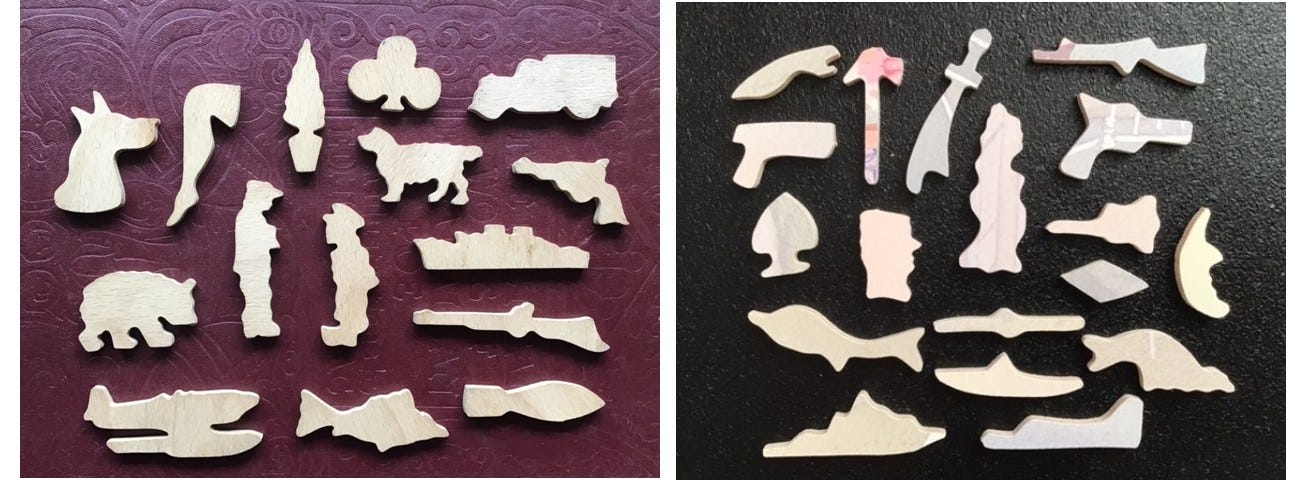
The figural pieces in both puzzles show little sign of having been selected to match the theme or mood of the puzzles except for a bit of a bias toward nautical-ness. From studying whimsies in other Victory puzzles from The Jigasaurus website after my assembly, randomness of the whimsies seems to be characteristic of the company’s puzzles.
The whimsies for Strolling seemed more crude than I thought I remembered from the one Victory Artistic puzzle that I had previously assembled. In fact, in some cases I still cannot figure out what they are intended to represent. (Is that an old-fashioned can opener on the upper left? And what the heck is that thing on the bottom right?) But from the Victory whimsies images I saw online I found that their quality is rather typical for its Artisan series, as well as the the later Gold Box ones made in the Spear era. But the Super-Cut whimsies in Catch are much better. In fact, the ones in my puzzle seem to be superior to most of the online Super-Cut ones.
I found that the whimsies in Strolling (especially the weapons) did little to increase my enjoyment of the puzzle, although they did make assembly easier. On the other hand, I enjoyed seeing the Catch silhouettes (despite the abundance of weapons) because they gave me evidence some speculation about when that puzzle may have been made.
I must admit that the cheeriness and surprise element of whimsies was one of the things that first attracted me to wooden jigsaw puzzles. But even with my limited experience (these are the 29th and 30th wooden puzzles I’ve assembled) I have now come to appreciate other aspects of good cutting more.
The 200 piece A Good Catch puzzle cost me £27 (about $32 USD or $42 CAN) from an eBay auction, and the 300 piece Strolling one cost me $40USD, bought from a fellow-member of the Facebook Wooden Puzzle Club. (Those prices don’t include the cost of shipping which I have to pay for either new or used puzzles.) In both cases this is less than half of the list price for new comparably-sized laser-cut puzzles, and much less than the price of new hand-cut ones.
The shortcomings in the cutting of figure pieces in these old factory hand-cut ones does not dissuade me from continuing to buy good vintage puzzles both as a frugal alternative and for the an enjoyable je ne sais quoi that I find in assembling puzzles from the past. But if someone has been introduced to wooden jigsaw puzzles through laser-cut ones, and one of the main appeals of wooden puzzles for them is their intricate and beautiful whimsies, the purchase of this kind of vintage puzzles might not be a good frugal alternative for them.








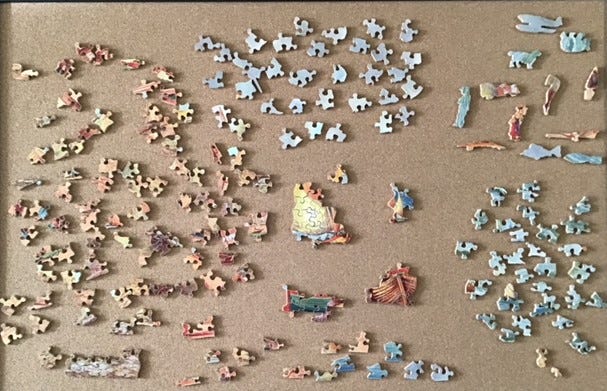




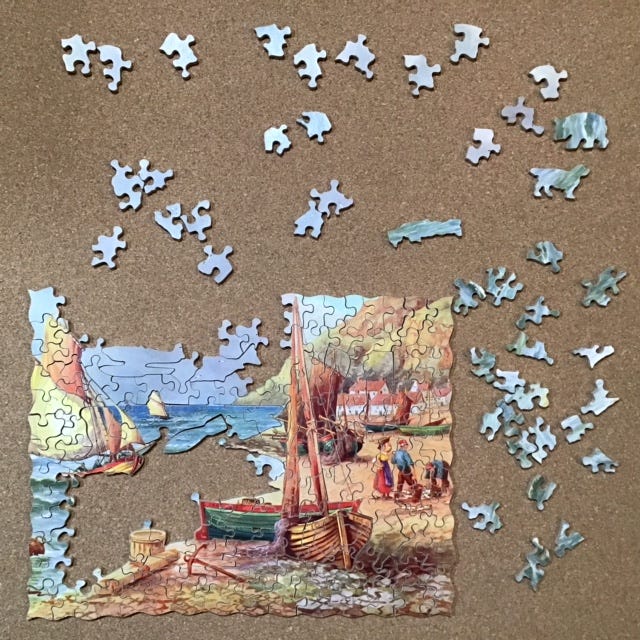
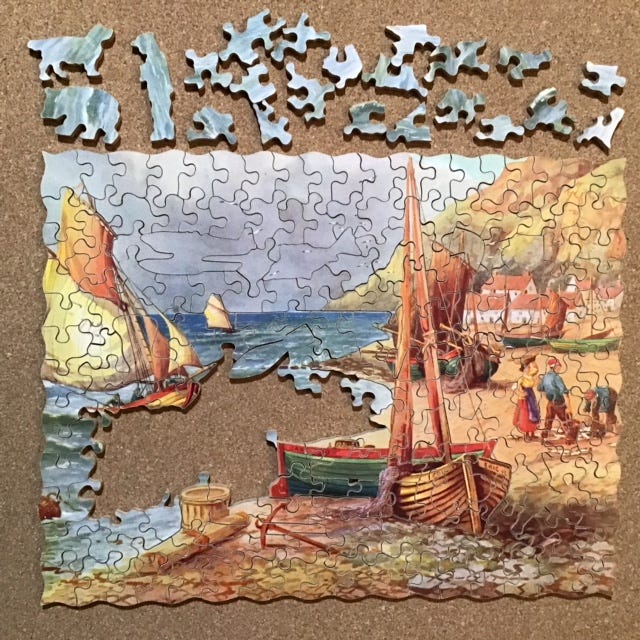
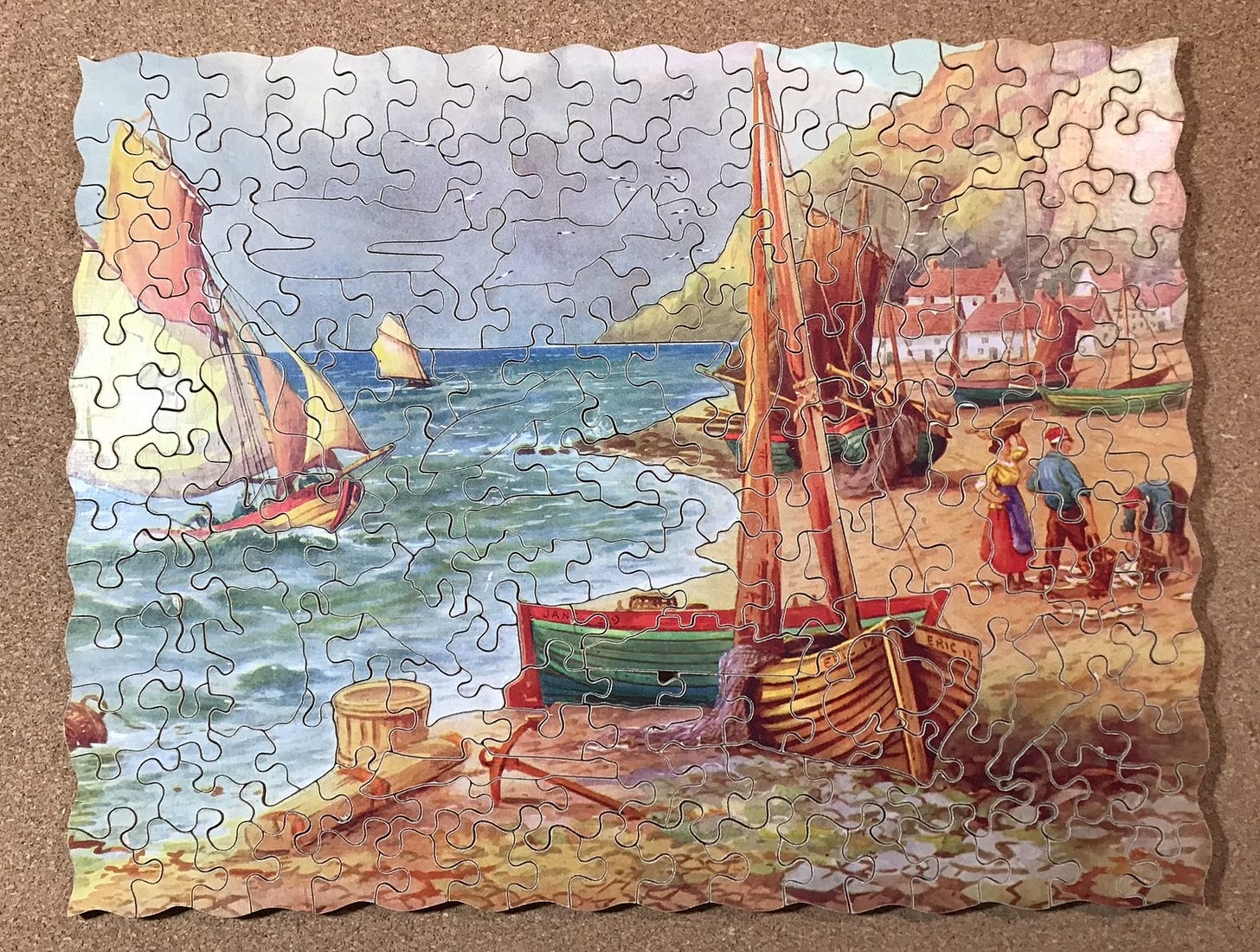
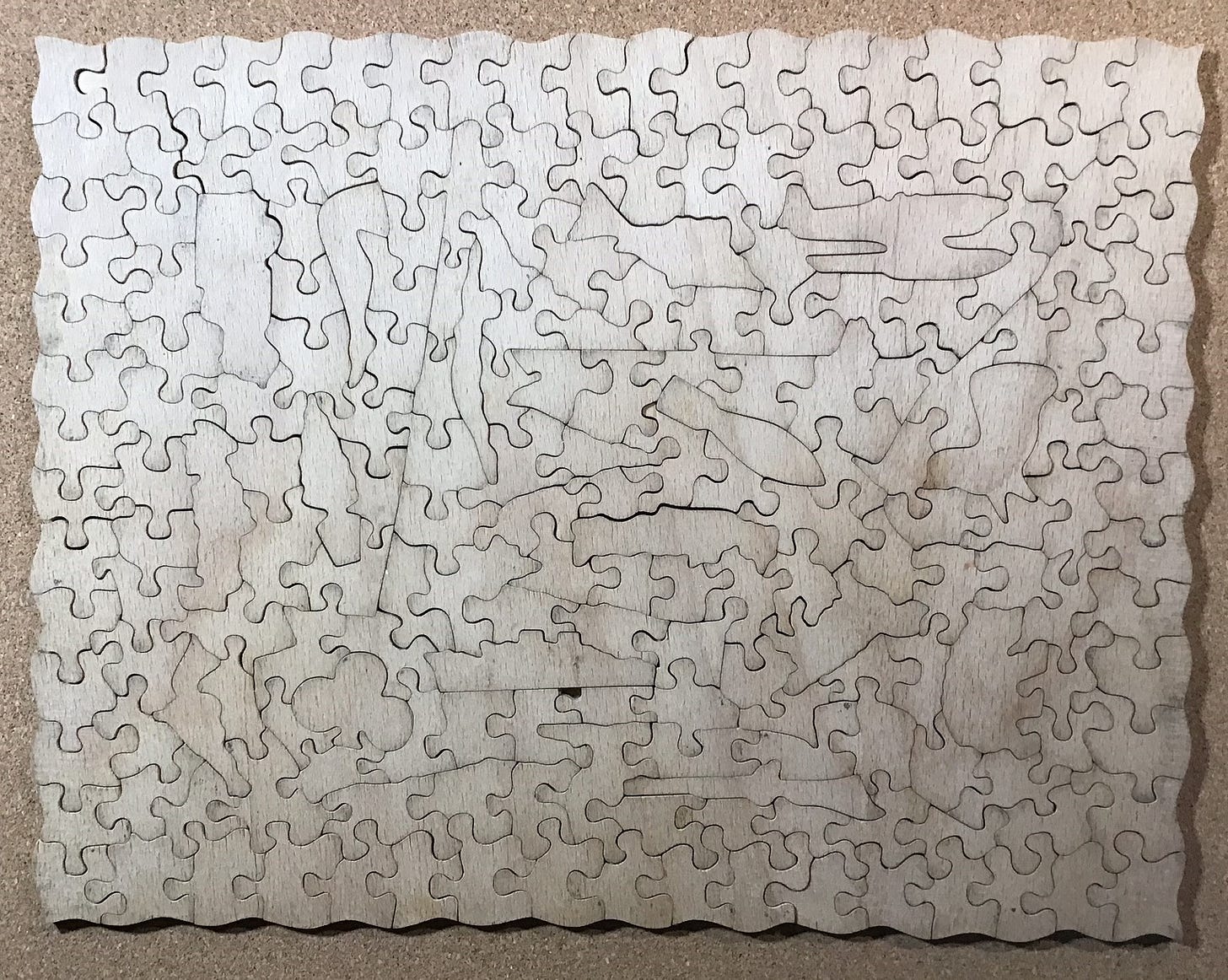
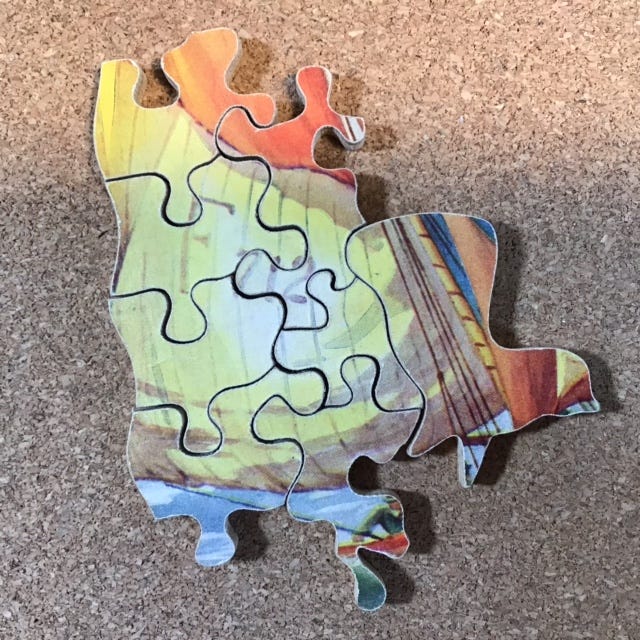


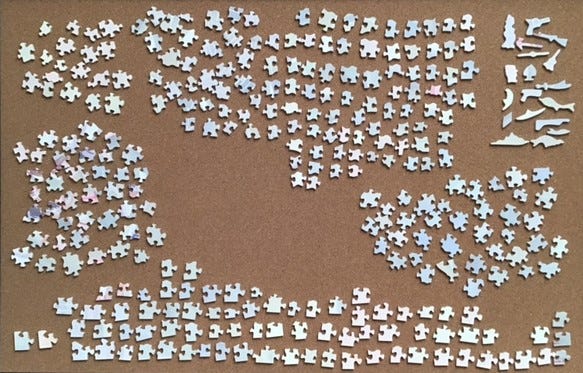






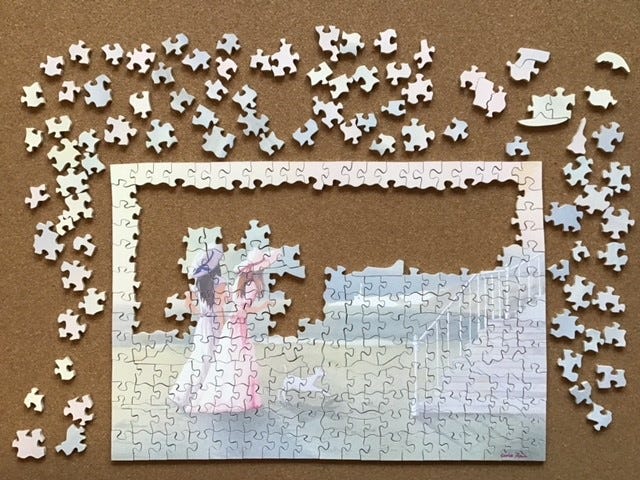



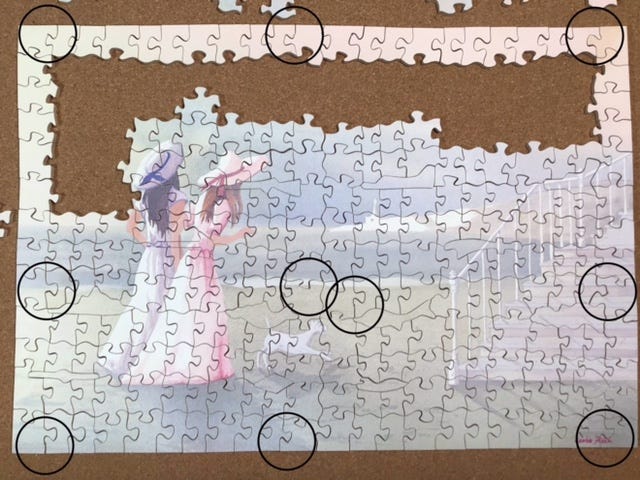

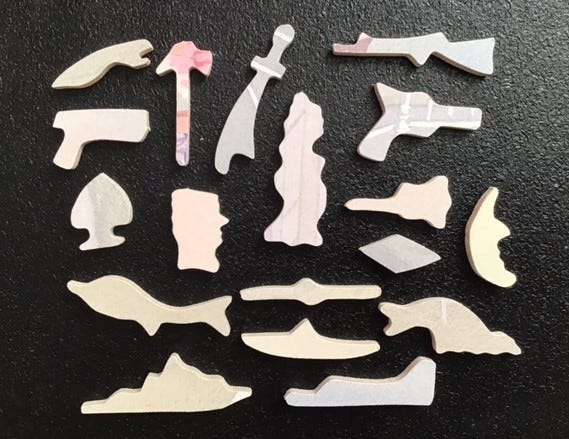


Good morning, Bill. I sympathized with you re: the loss of part of your writing during a cut-and-paste episode. I wonder if an automatic backup add-on to your computer/word processor could be worthwhile. I use one called Time Machine. I do not know if it would have prevented the loss of text given particular hardware and software you use. In any case, I sympathize.
Of the puzzles discussed today, I like "A Good Catch" best. I feel like I may have seen that picture elsewhere, too. In any case, it's a beauty. I also got a kick out of your speculation that the "bomb" figural piece was meant to fall harmlessly into the water. The other beach images were a bit too per my tastes, though well discussed by you. Thanks for your research and writing.